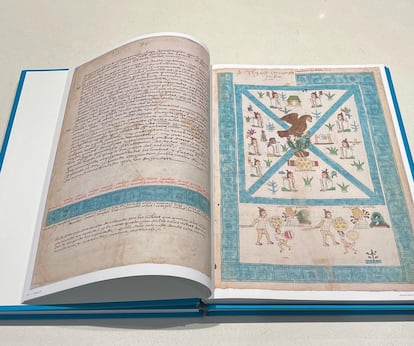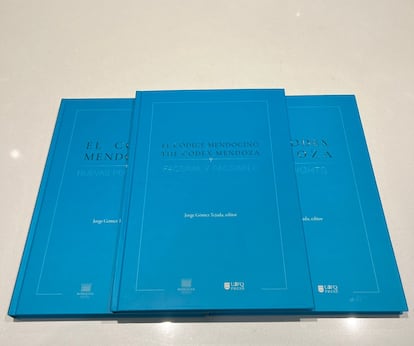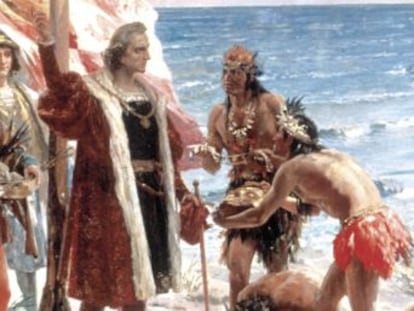‘The Codex Mendoza was used to legitimize Spanish conquest of the Aztecs’
A new facsimile and study of the 16th century manuscript explores the document’s political use at a time when Spain was debating the moral legitimacy of colonial subjugation in the Americas

“The Codex Mendoza embodies an overwhelming tragedy: the dissolution of a civilization.” Thus reads the foreword to a new analysis, accompanying a new facsimile, of the famous 16th century manuscript, one of the most celebrated documents of artistic collaboration between Indigenous artists and Spanish interpreters in the history of Mesoamerica, which was created sometime between 1542 and 1552. The codex’s 71 folios feature a combination of Nahua painting and writing, accompanied by passages of Spanish text, which narrate the history of the Mexica people from the founding of Tenochtitlan (modern-day Mexico City) in 1325, to the death two centuries later of Moctezuma Xocoyotzin (Moctezuma II). Viceroy Antonio de Mendoza, the colonial administrator who commissioned the book’s creation, intended to produce a document that surveyed the economic, political and social life of Spain’s recently conquered land. And, according to a new study, also to employ it as propaganda. “This codex was used to legitimize the Spanish conquest of the Aztecs,” explains Jorge Gómez Tejada, professor of Art History at the Universidad San Francisco de Quito in Ecuador and the editor of a new facsimile edition of the manuscript, co-published by the Universidad San Francisco de Quito and Oxford University’s Bodleian Library.
The new volume is the first interpretive reproduction of the Codex Mendoza, which analyzes the text from an artistic and literary perspective, and the first to be published simultaneously in both Spanish and English. In addition to the facsimile of the codex itself, the new volume includes a book of essays and articles divided into 14 chapters and composed by 13 researchers, who explore the codex’s history, interpretation, and reception. The findings of this collaborative research project were presented at the Colegio Nacional, a prestigious honorary academy in Mexico City, where the director of the Proyecto Templo Mayor, archeologist Leonardo López Luján, hosted Gómez Tejada who delivered a lecture on the codex, which is an essential document in understanding the history of pre-Hispanic Mexico.

“The Codex Mendoza is one of the most beautiful examples of tlacuilolli, the Nahua art of painting and writing,” says Gómez Tejada, highlighting one side of the contradiction suggested by his new thesis: “The document was created with the intention of sending it to Europe to influence an ongoing national debate in Spain, raised by Bartolomé de las Casas, among others, concerning the legitimacy of the conquest, which essentially boiled down to the question: does one nation have the right to dominate another simply because it considers it inferior? The original narrative of the codex shows that the Mexica were a sovereign nation with laws and a political system, that they possessed humanity - a revelation that the conquerors received with displeasure, considering that their justification for the occupation of Tenochtitlan was that the inhabitants were ungovernable,” Gómez Tejada says.
The codex’s juxtaposition of Nahua iconography and Spanish gloss, or marginal textual annotations, is not the only way the manuscript casts two systems of thought in contrast: rather than using deer skin or amate, a traditional Aztec paper made from tree bark, the Codex was painted by Mexica scribes using sheets of Spanish paper. It was also bound in the tradition of Spanish book-making. The original Codex Mendoza is currently housed at the University of Oxford’s Bodleian Library in England, where it has been kept for the last 363 years. Before it was gifted to the library by the executors of the estate of John Selden around 1659, the content of the manuscript was available for study through a series of woodcut reproductions, published in the third volume of Purchas his Pilgrimes, a collection of travel stories published by English cleric Samuel Purchas in 1625.
In 1831, the Codex Mendoza became the first manuscript to be reproduced entirely in color, as part of the first volume of Antiquities of Mexico, a collection of lithographic facsimiles compiled and published by Lord Kingsborough, an Irish antiquarian. This publication, like that of later photographic facsimiles published in the 20th century, would prove too costly to enjoy wide circulation. But in recent years, new technology has made it possible to reproduce its pages digitally and online, in addition to enabling more accurate studies of the original colors using non-destructive instrumental analysis and multispectral imaging. Thus, the new version of the codex features more accurate images and coloring, in addition to a closer approximation of the true size of the pages, which measure roughly 31 by 21 centimeters in the original.
“There is a part of the codex that shows the sort of education Mexica society provided to its children, that shows how this society had the capacity to administer public policy,” Gómez Tejada explains. “The debate at the time centered around whether the people of Tenochtitlan had any humanity, were able to love, to live in a society; this book shows us the argument for Mexica sovereignty, and it shows that the Mexica were a civilized society.” The most complete edition and study of the codex prior to this most recent one was published by the University of California in 1992. It’s authors, Frances Berdan and Patricia Rieff Anawalt, produced an extensive facsimile edition with translations and accompanying analysis. In 1997, they published a summary edition titled Essential Codex Mendoza. Until now, they had yet to use the new cameras, printing presses, and digital media available today to create a new version of the original Oxford edition. “The approach we took to the manuscript is of the sort we might take to a work of art in attempting to understand its materiality, its internal dynamics; the analysis of its narrative priorities and the way in which images function as rhetorical tools to convey an idea and to persuade,” Gómez Tejada told EL PAÍS.
Ultimately, however, the narrative of the codex reveals the prejudices and ignorance of the colonial world view, according to López Luján, a Mexican archologist and the director of the Colegio Nacional. “It references tributes to be paid in objects of gold, but in all of the offerings we’ve encountered in our research, we’ve found hardly any gold,” López Luján says. “To date, over the course of 44 years of excavations, we’ve encountered less than one kilogram of gold objects in Mexico. In countries like Colombia, Ecuador, Bolivia or Costa Rica, there are large museums of gold, associated with the Central Bank. What we did find in our excavations, and what also appear in the codex, are live eagles. Our findings indicate that live eagles were brought to Moctezuma’s vivarium, which was located where Mexico City’s Palacio Nacional is today. They were held in cages and served as amusement for the king and his court, but also as raw materials [for making garments and other items].” Most of these animals were used for rituals and sacrifices at the Templo Mayor.

The history of the Codex Mendoza is as rich as it is controversial. Throughout the 16th century, the manuscript is cited in the works of André Thevet, cosmographer to the French Court, and in the writings of English geographers Richard Hakluyt and Purchas, historians of exploration whose works were reproduced throughout the 17th and 18th centuries in texts on American history and treatises on ancient writing. In the 19th century, the codex served as an important source for Mexican historians and geographers, and as the basis for Antiquities of Mexico, Lord Kingsborough’s extravagant attempt to prove a connection between the original inhabitants of the Americas and the lost tribes of Israel. In the 20th century, the Codex Mendoza stood out as an important source of historical knowledge about the Mexica people beyond just the biographies of the civilization’s great rulers. And now, with an analysis that focuses on the manuscript as a work of art, the codex’s materiality, iconography, and narratives, both explicit and implicit, allow us to appreciate the document in a new light, and to create new contexts for understanding it, and new lines of inquiry.
From the time of its creation, the Codex Mendoza has garnered widespread international importance, as evidenced by its early voyages across the Atlantic. The European paper on which it was created must have crossed the Atlantic back and forth in rapid succession in the early 1540s. On its final folio, the Spanish commentator notes that the manuscript, upon completion, remained in Mexico for less than ten days before the fleet that would transport it to Europe set sail. After a period in Renaissance France, it arrived in Oxford. Throughout almost five hundred years of history, the codex has had many faces, each complementing the other, representing different angles of interpretation, reflecting and celebrating a culture in collapse through the recording and interpretation not only of its history, geography and daily life, but also of its art, language and pictorial writing. “The Codex Mendoza is a text that is in a state of constant change; thinking about it from the perspective of art and storytelling can help us understand it better,” says Gómez Tejada.
Tu suscripción se está usando en otro dispositivo
¿Quieres añadir otro usuario a tu suscripción?
Si continúas leyendo en este dispositivo, no se podrá leer en el otro.
FlechaTu suscripción se está usando en otro dispositivo y solo puedes acceder a EL PAÍS desde un dispositivo a la vez.
Si quieres compartir tu cuenta, cambia tu suscripción a la modalidad Premium, así podrás añadir otro usuario. Cada uno accederá con su propia cuenta de email, lo que os permitirá personalizar vuestra experiencia en EL PAÍS.
¿Tienes una suscripción de empresa? Accede aquí para contratar más cuentas.
En el caso de no saber quién está usando tu cuenta, te recomendamos cambiar tu contraseña aquí.
Si decides continuar compartiendo tu cuenta, este mensaje se mostrará en tu dispositivo y en el de la otra persona que está usando tu cuenta de forma indefinida, afectando a tu experiencia de lectura. Puedes consultar aquí los términos y condiciones de la suscripción digital.
More information
Últimas noticias
Most viewed
- Reinhard Genzel, Nobel laureate in physics: ‘One-minute videos will never give you the truth’
- Oona Chaplin: ‘I told James Cameron that I was living in a treehouse and starting a permaculture project with a friend’
- Pablo Escobar’s hippos: A serious environmental problem, 40 years on
- Why we lost the habit of sleeping in two segments and how that changed our sense of time
- Chevy Chase, the beloved comedian who was a monster off camera: ‘Not everyone hated him, just the people who’ve worked with him’











































